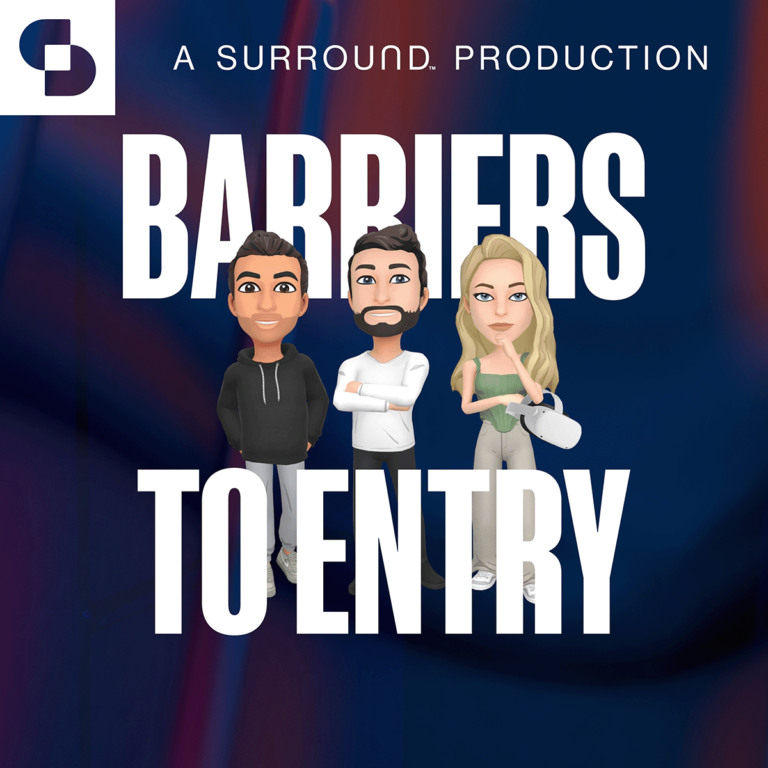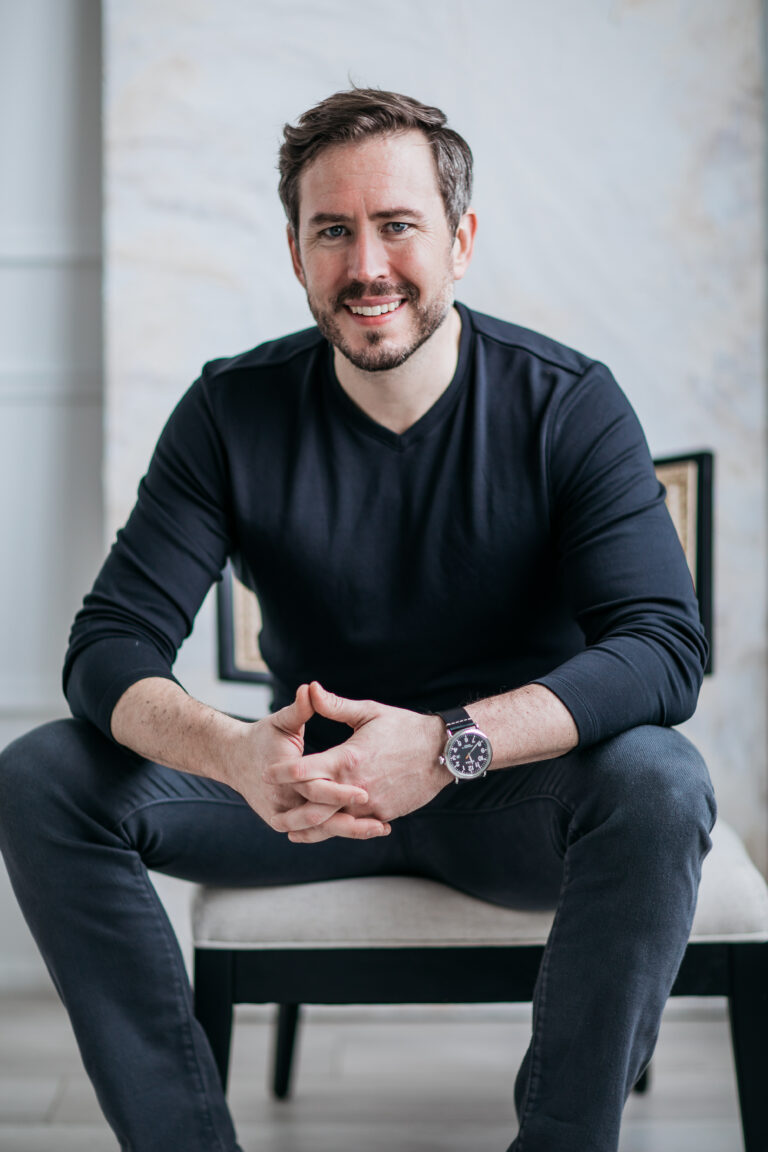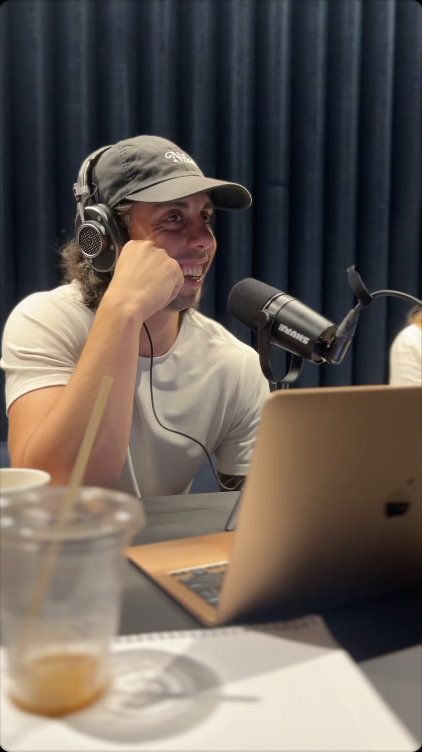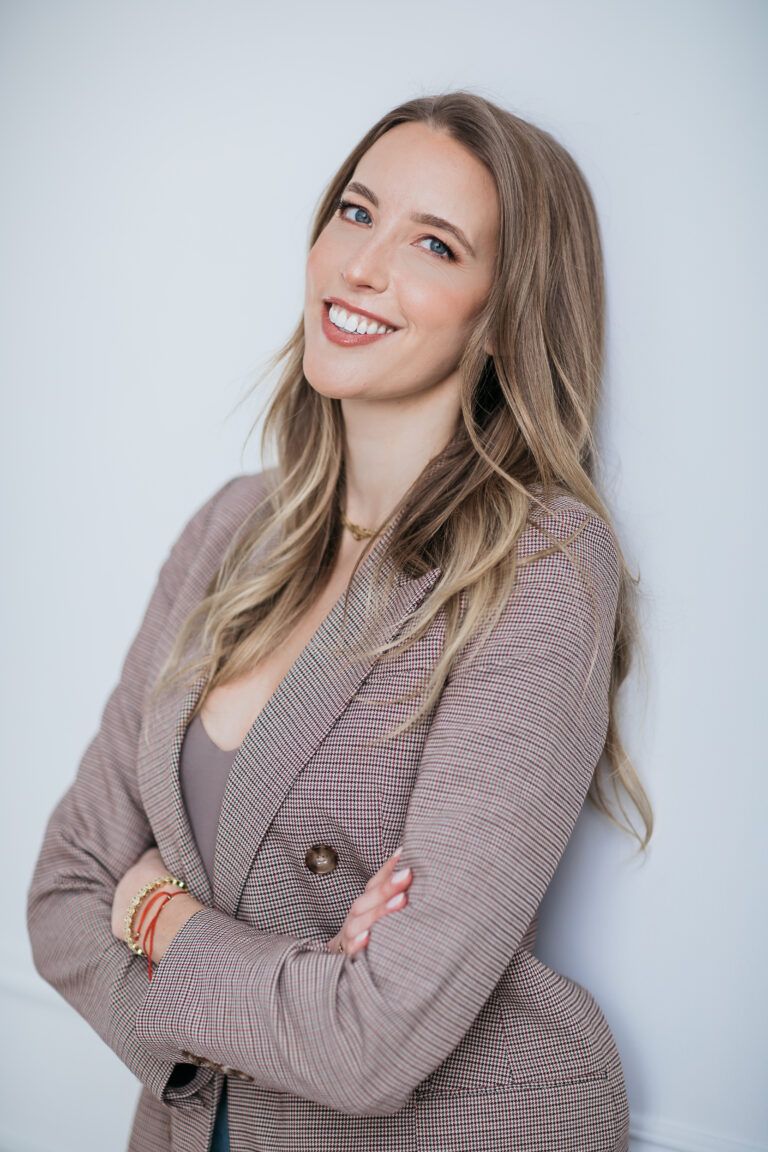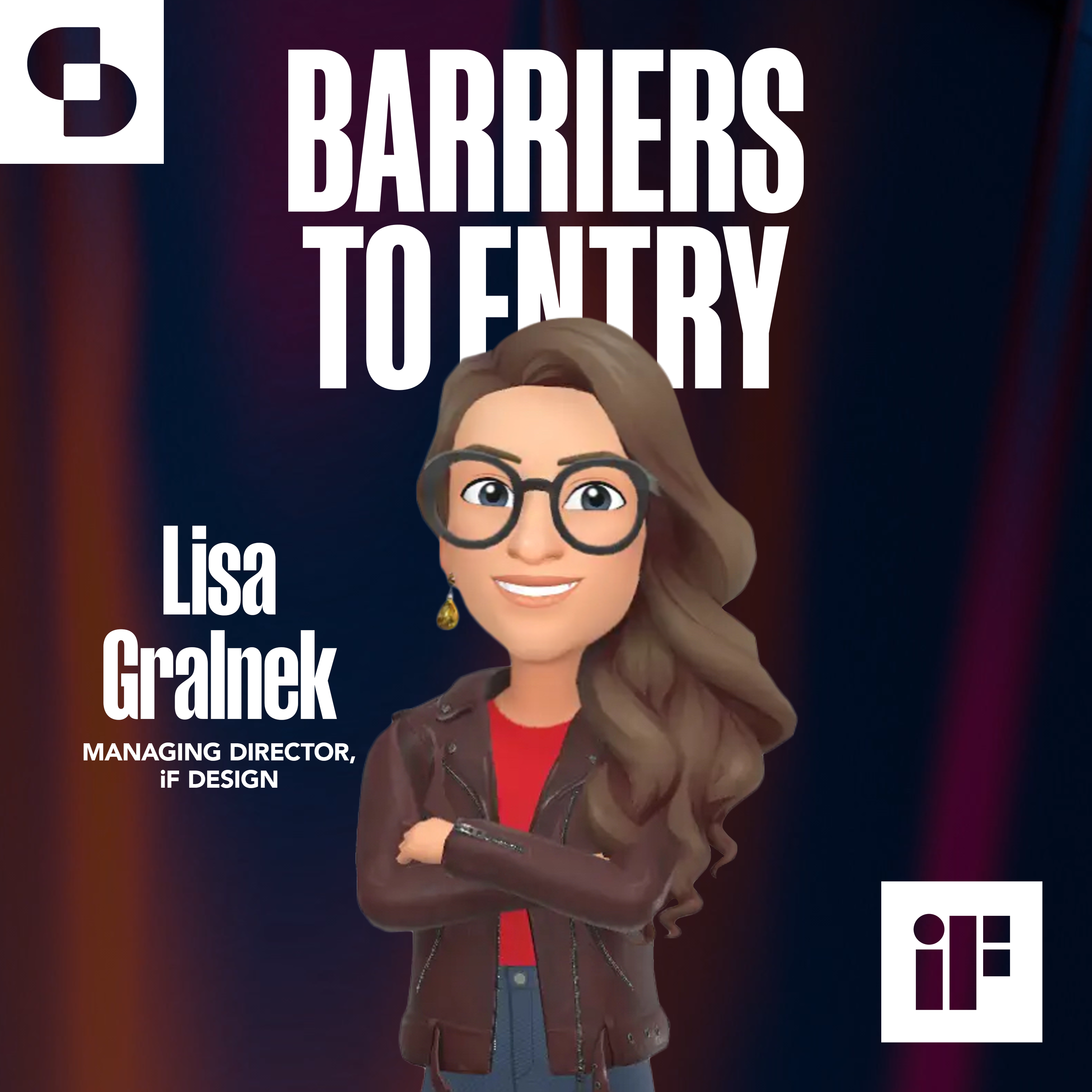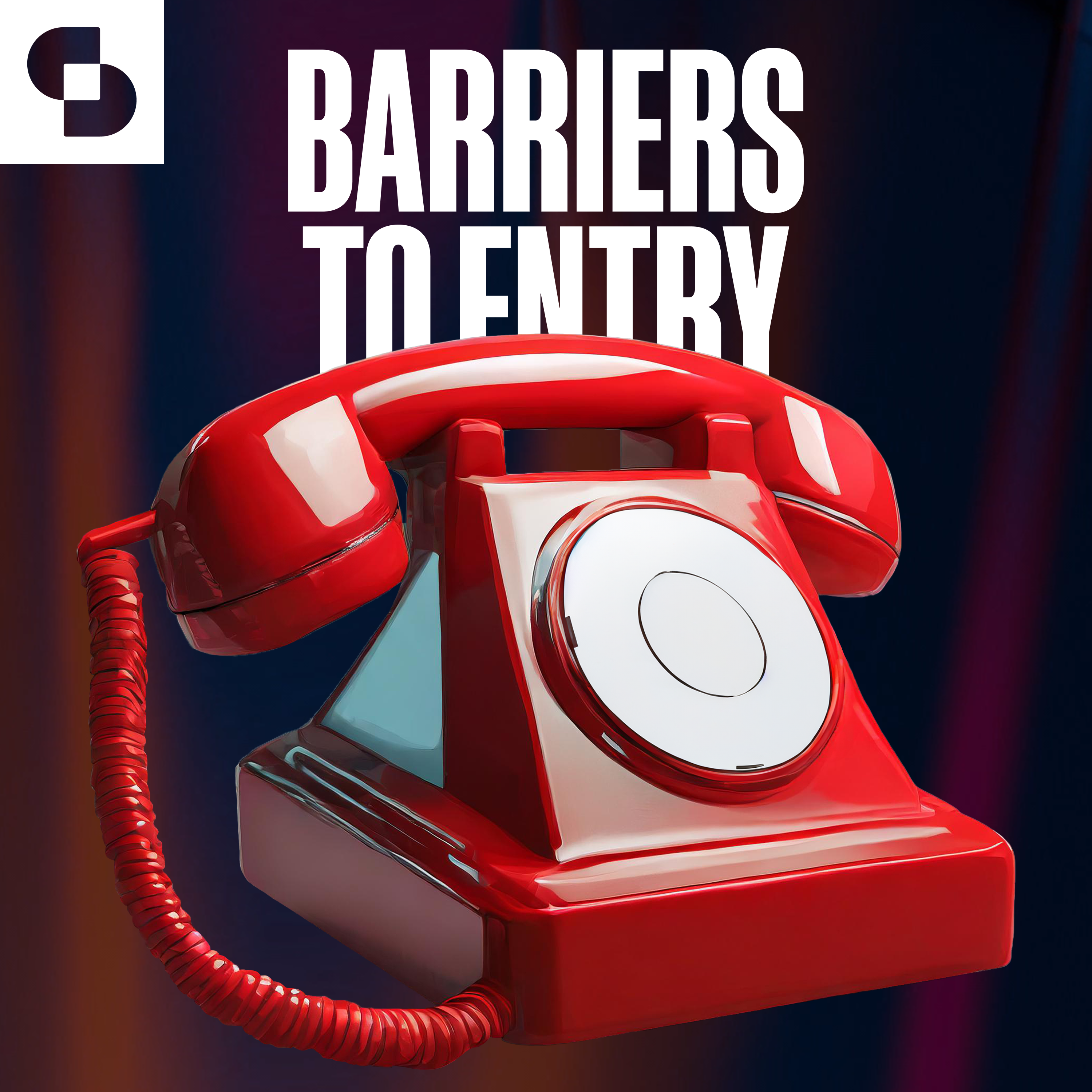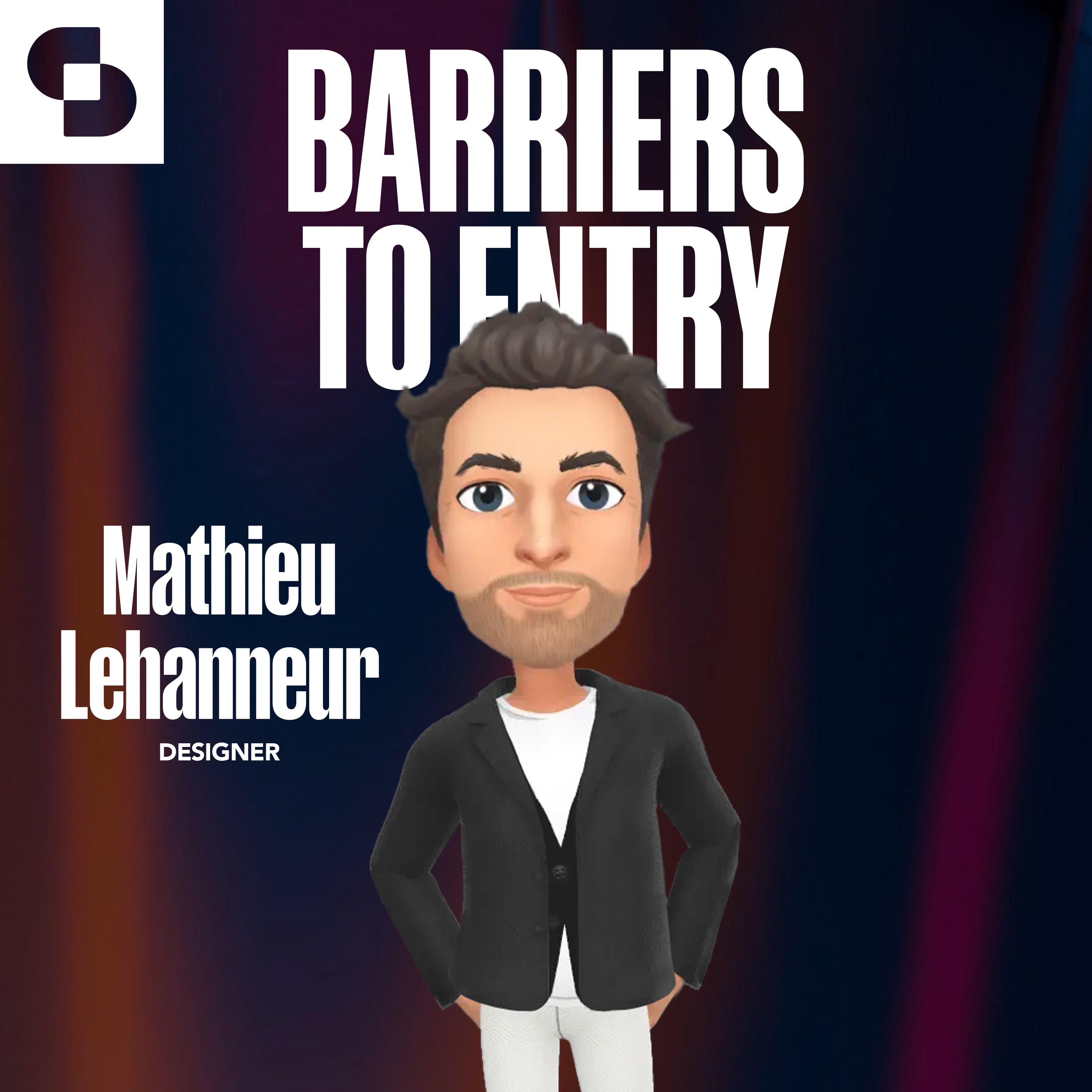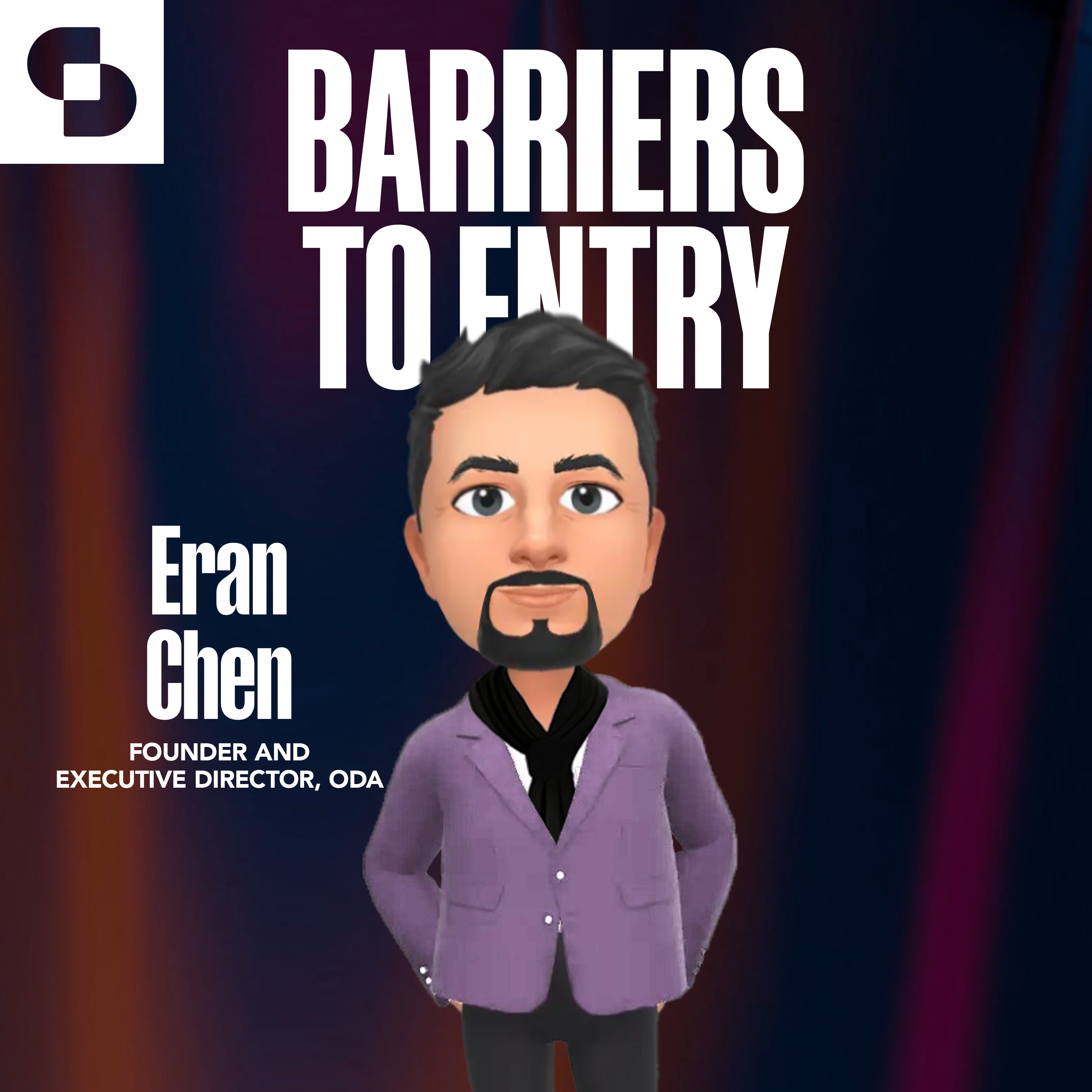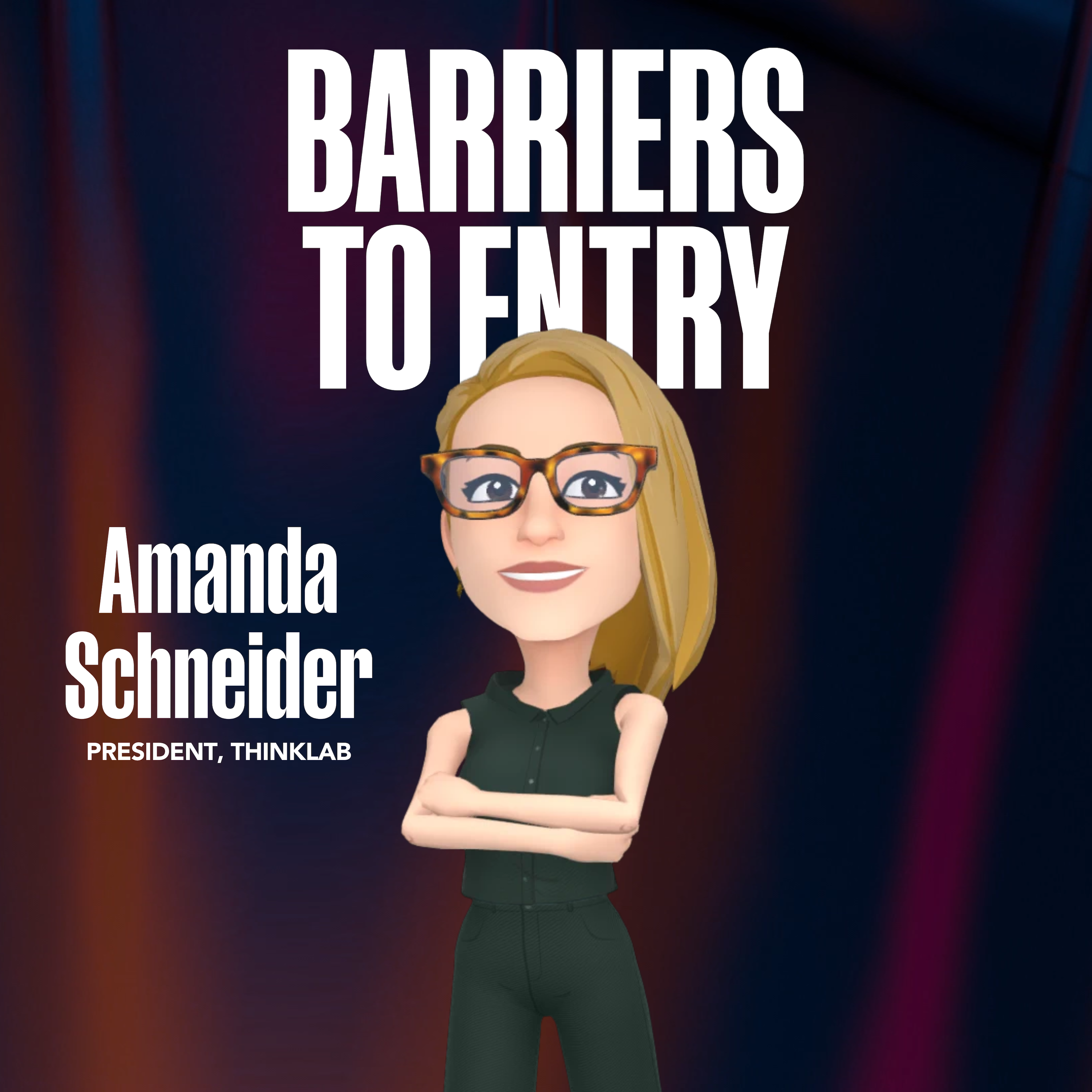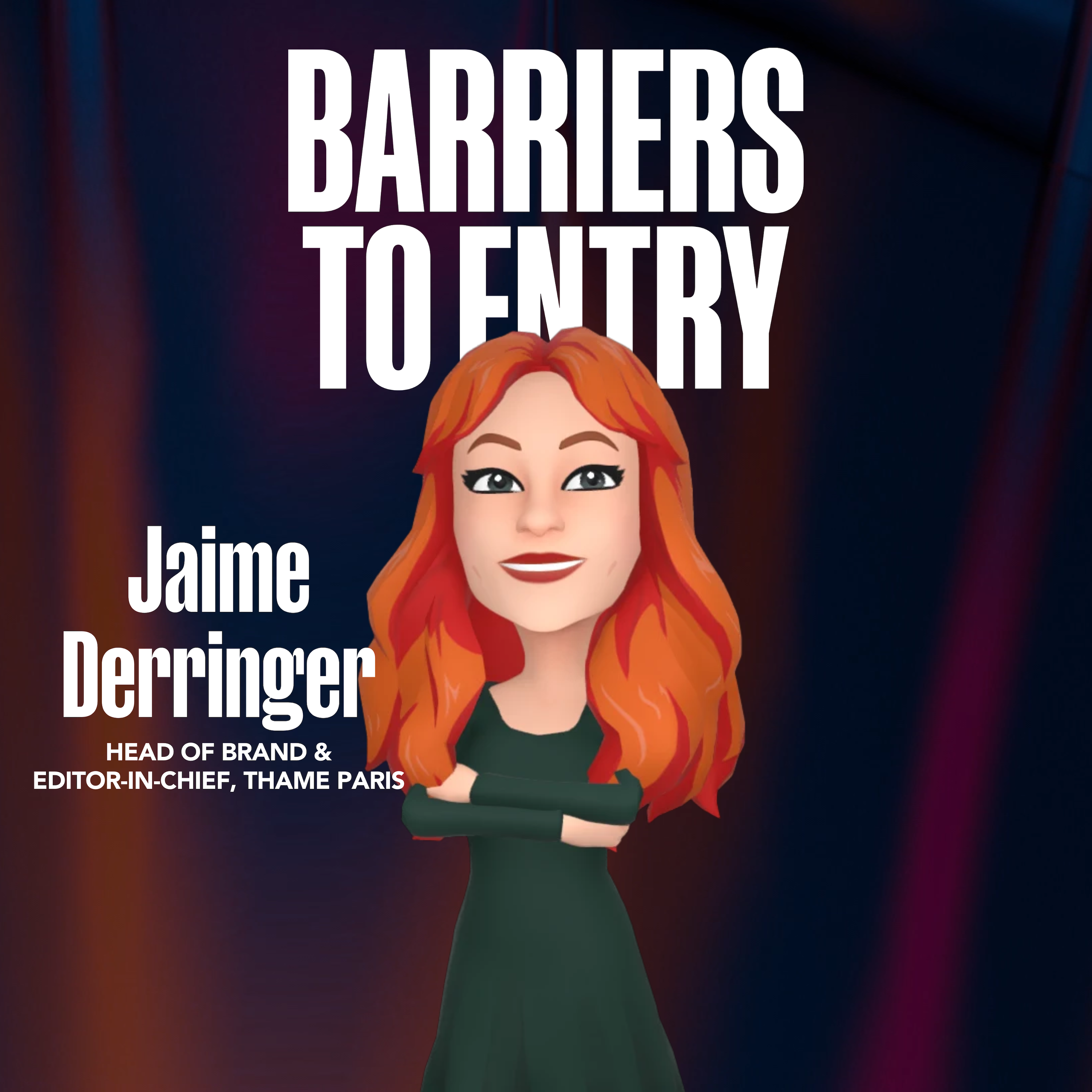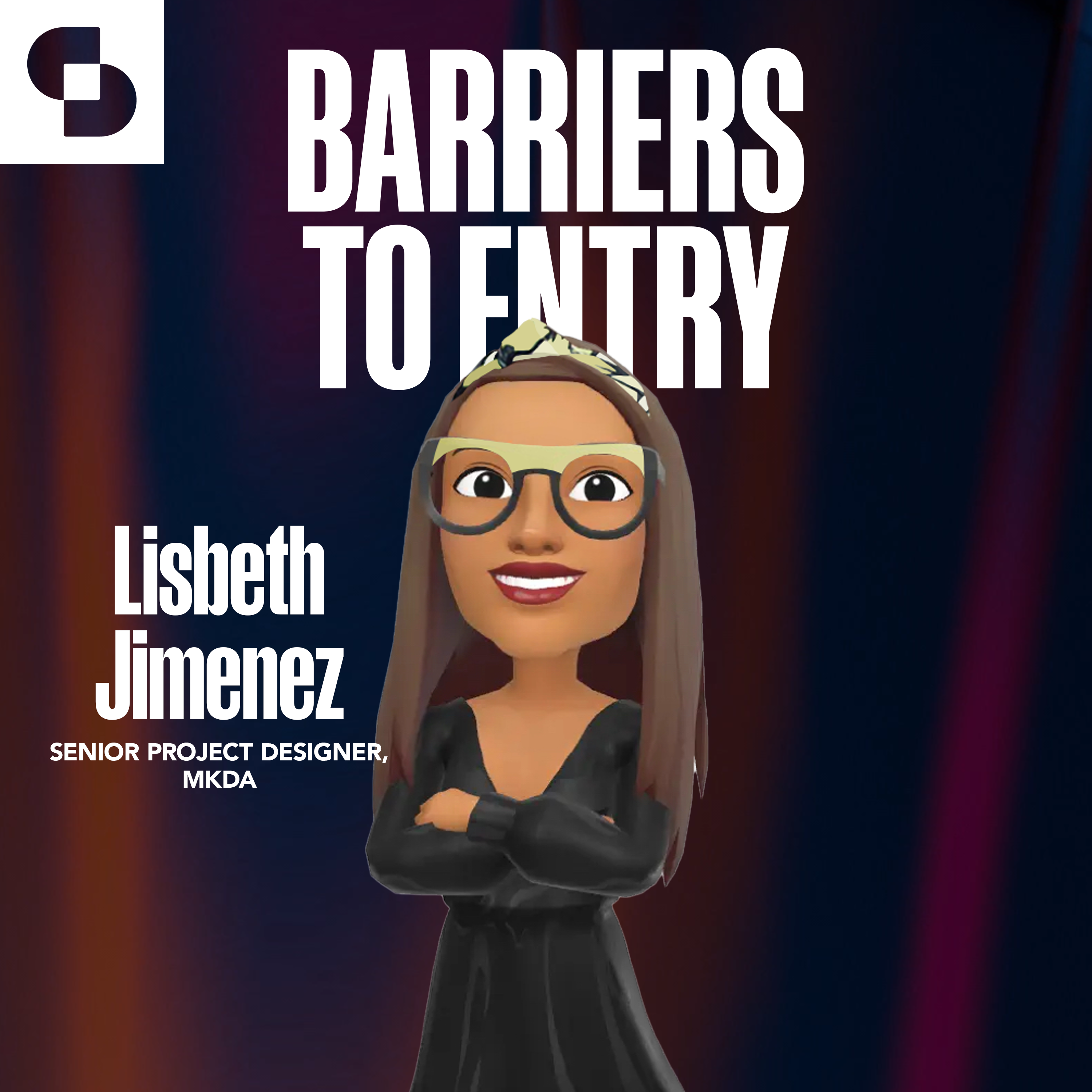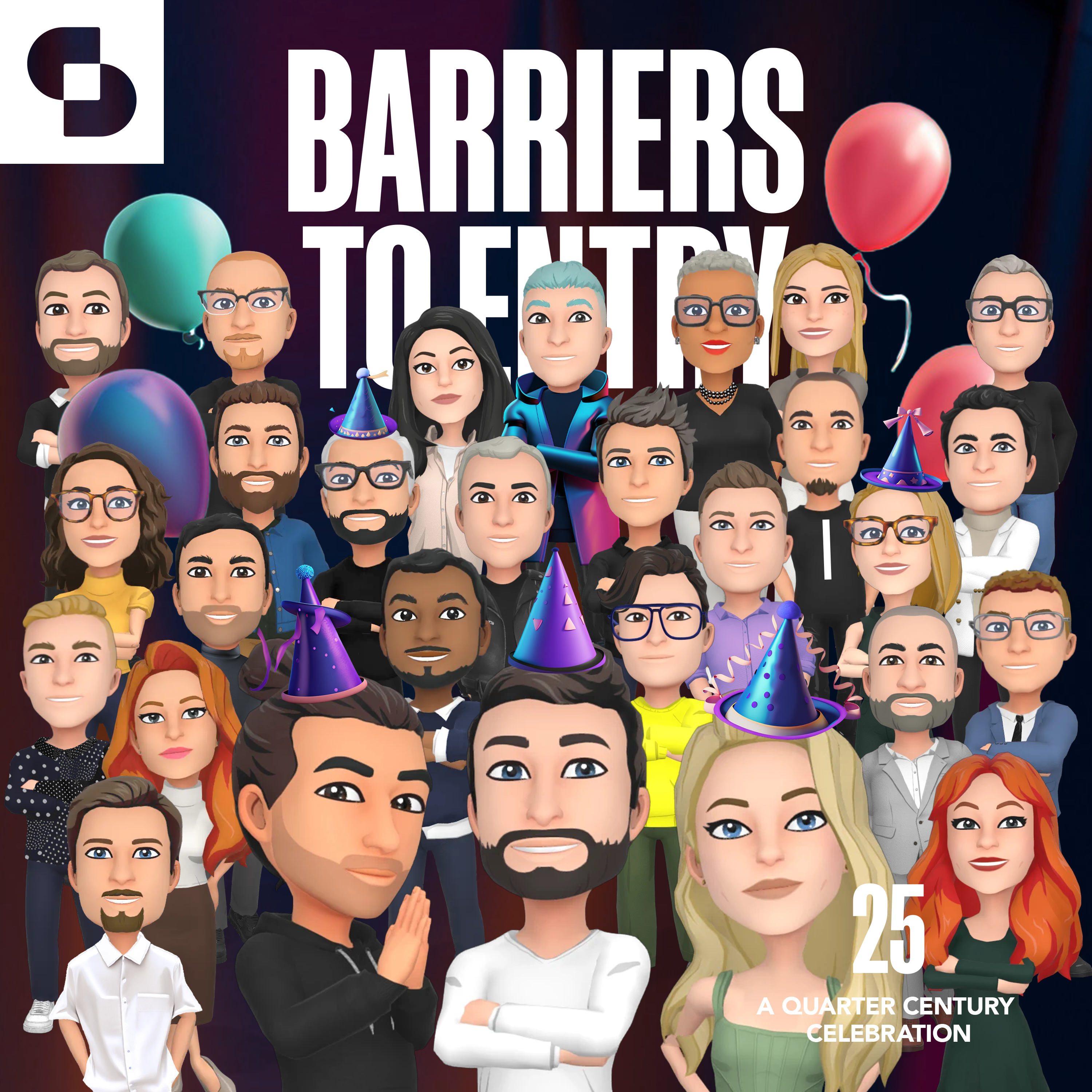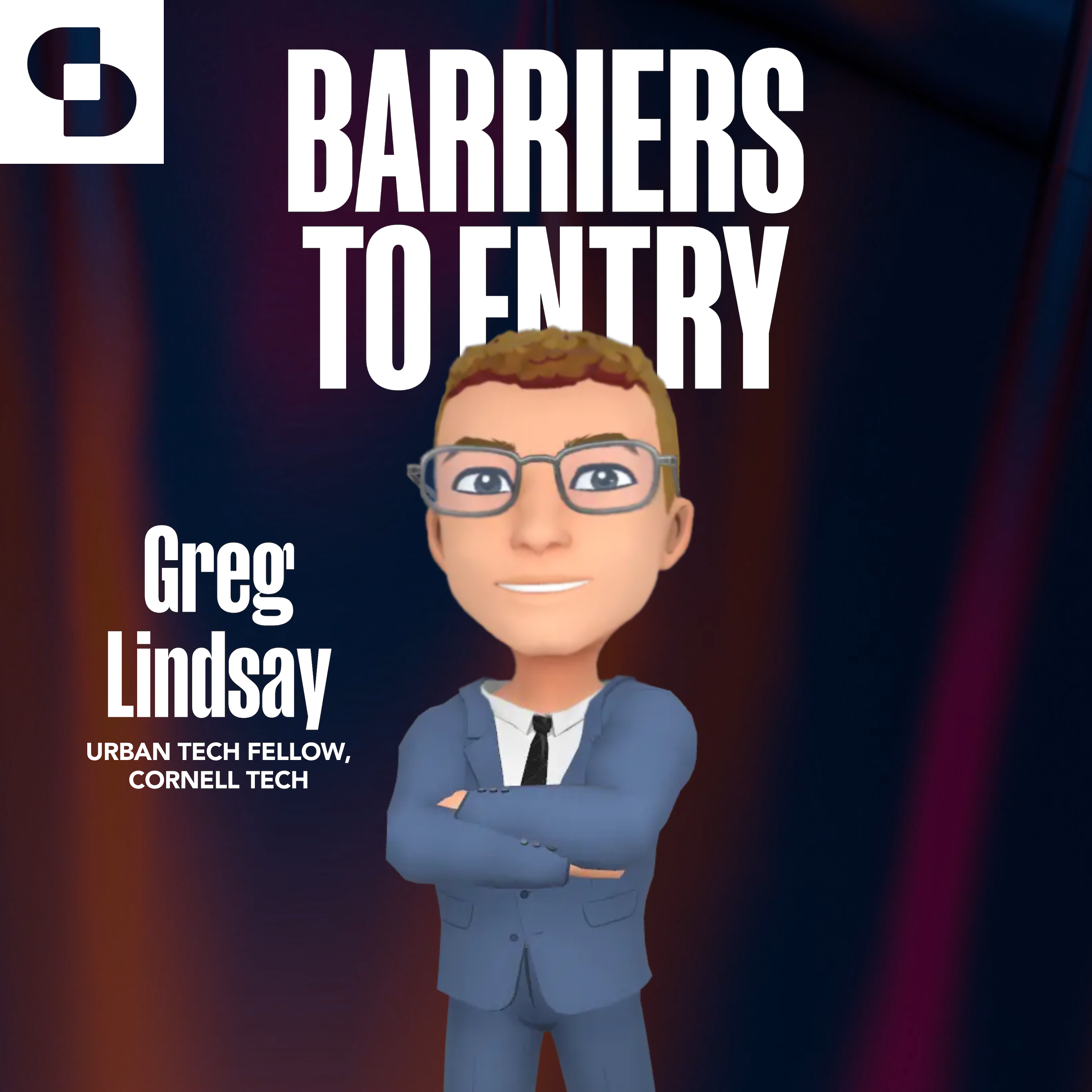This week the gang is joined by Tom Puukko, the serial entrepreneur and founder of wallcoverings disruptor, Feathr, as well as new metaverse-focused startup, Superdwell. Tune in for a discussion that touches on everything from the conditions that uncover the opportunity to create new products, to the state of early adopters of metaverse in the A&D industry to Phil Collins helping to sell chocolate.
Connect with Tom Puukko on LinkedIn!
Moments to check out:
– Finding inspiration at the intersection of design and technology (start at 7:08)
– The Superdwell origin and the dawn of the next techinological shift (start at 11:47)
– ‘Ah ha’ moments that evolve our understanding of a digital world (start at 22:16)
– The early adopters of the A&D industry (start at 32:42)
Connect with our hosts on LinkedIn;
References and resources:
- Feathr: https://www.feathr.com/
- SuperDwell: https://www.superdwell.co/
- Blender Tutorials on YouTube: https://www.youtube.com/c/BlenderTuts/videos?app=desktop
- digby Design Authenticator Launch with Heller: https://www.dezeen.com/2023/01/05/digby-design-authenticator-heller-nft-authenticator-launch/
Discover more shows from SURROUND at surroundpodcasts.com. This episode of Barriers to Entry was produced and edited by SANDOW Design Group. Special thanks to the podcast production team: Hannah Viti, Wize Grazette, Kasey Campbell and Samantha Sager.
00;00;05;01 – 00;00;19;20
Tom Puukko
So everything we’ve been doing so far with desktops, with mobiles, with tablets, it’s a very unnatural way to interact with content and with other people. Where as Metaverse, VR combined creates a much more natural internet.
00;00;20;05 – 00;00;41;28
Tessa Bain
Welcome to Barriers to Entry, the rapidly maturing podcast, where every episode we get into it with the leaders, the designers, the early adopters and the influencers who are helping to shape what web3, the metaverse, the blockchain and more are going to mean for the architecture and design industry. I’m Tessa Bain and as always, I’m joined by my illustrious cohost Andrew Lane and Bobby Bonett.
00;00;42;16 – 00;01;03;21
Andrew Lane
We’re super excited today to be digitally traveling across the pond to welcome Tom Puukko, who is a serial entrepreneur. He’s going to get into it with us about the entire entrepreneurial process, but also about a really cool new startup that he is bringing to life in the metaverse space specifically for the A+D industry.
00;01;03;29 – 00;01;22;10
Bobby Bonett
First off, I have to give a shout out to Tom on the branding side, Hyper Feathr and Super Dwell. We’ll learn all about all of those today, but quite the branding expert and I think that comes from Tom’s pedigree as a creative strategist. So have a listen, be inspired and maybe you’ll get some ideas for your next new business from Tom.
00;01;24;04 – 00;01;45;09
Andrew Lane
We are so thrilled to be bringing you our first intercontinental podcast guests. Today, we’re welcoming a serial entrepreneur who found his way to the design industry through technology. You may know him from his previous startup, Feathr, which changed the game and wall coverings, and we’re excited to have him on to talk about his latest venture, Superdwell, which is bringing the Metaverse to the architecture and design community.
00;01;45;21 – 00;01;47;02
Andrew Lane
Welcome, Tom Puukko.
00;01;47;10 – 00;01;55;04
Tom Puukko
Hey, thank you for having me. It’s a pleasure to chat to you guys. Looking forward to delving into all things metaverse and beyond.
00;01;55;09 – 00;02;04;22
Andrew Lane
So we’re going to talk Superdwell, we’re going to talk Metaverse today, but this is by no means your first startup. Can you tell us a little bit more of the origin story, the backstory of what got you here?
00;02;05;05 – 00;02;07;22
Tom Puukko
Yeah, sure. I mean, how far you want me to go back?
00;02;08;02 – 00;02;10;15
Andrew Lane
Birth is usually where we start on these things.
00;02;10;15 – 00;02;31;15
Tom Puukko
Yeah, that’s where it started for me too. But no, actually, the kind of starting point for how I ended up with multiple startups is about the mid 1980s. So I had a slightly strange childhood. My father, he rejected all kind of modern technology. So no TV. We never went on holidays. Even car was a bit like, Do we need one of those?
00;02;31;29 – 00;02;53;24
Tom Puukko
But he loved two things. One, he loved everything ancient. So our house was filled with strange artifacts from Egyptology, Iron Age bones, pieces he’d found in museums. But he also loved all things future. So even though he rejected things like television, he was really into computers early on. So we had amazing computers in the house in the mid-eighties.
00;02;54;01 – 00;03;13;19
Tom Puukko
And so from the mid eighties onwards, I was into this very tech driven world, but also very connected to the context of that technology. In the past, often I was learning about the how did computers first appear in kind of classical Greek times. And when it came to me starting my working career in the late 1990s, I found two things.
00;03;13;19 – 00;03;31;20
Tom Puukko
First of all, I was the guy in the room who knew how to use computers so people would have a presentation and they go, Oh, we’ve just got this new projector. We were using OHP’s. You remember OHP’s, those weird, like the slide things, and we’ve got this projector, we don’t know how it works. And I’d come in and I go to use this bit in here.
00;03;31;20 – 00;03;53;04
Tom Puukko
They’d go, man genius, How do you know this stuff? And the second thing that happened is I found because I hadn’t grown up purely in like a tech world, but also with this kind of connection to a lot of history and old literature. I had a kind of a skill for explaining new technology to people in a way that made them feel very comfortable with it, not scared of it, and easy for them to onboard themselves and their companies.
00;03;53;11 – 00;04;27;26
Tom Puukko
So after a couple of years of working, these two sides came together. I was working in marketing and advertising for various agencies in London, and I rolled out, first of all, a unit within a company. And then shortly after that, my first business found out, which was a digital marketing consultancy called Hypr, and our whole starting point and all kind of success came from our ability to talk to big international clients about technology in a way that didn’t make them scared of it, didn’t make them think that we were just going to charge them a whole lot of money to make something that was complex and they wouldn’t know how to use.
00;04;28;14 – 00;04;34;13
Andrew Lane
And you were evolved by beyond slide projectors, I’m assuming, at this point. What were some of the problems that Hypr was helping people solve?
00;04;34;23 – 00;04;47;12
Tom Puukko
This was so this was early 2000s and the very first iterations of Internet business, Internet marketing. One of the early kind of successes we had was with a chocolate company. I don’t know if you’re familiar with Cadbury’s.
00;04;47;24 – 00;04;48;19
Andrew Lane
I heard of them. Yeah.
00;04;49;03 – 00;04;50;05
Tom Puukko
Yeah. So big.
00;04;50;05 – 00;04;50;13
Tessa Bain
Yeah.
00;04;50;20 – 00;05;12;18
Tom Puukko
Now big, the big chocolate company in the UK, they came to us with a new campaign they were doing, which didn’t feature any chocolate to, but featured a gorilla playing the drums to a Phil Collins tune. Something in the air tonight to represent the spirit of when you ate the chocolate. How did you feel that kind of emotional release?
00;05;12;28 – 00;05;30;16
Tom Puukko
You must know the drum solo. They initially came to us and said, “We want to do we want a big website. You want to put our ad on a website” and we said, “Don’t, please don’t build a website because no one is going to come and look at your website.” The first thing going to do is they’re going to go online, they’re going to start looking on the video hosting sites.
00;05;30;18 – 00;05;49;24
Tom Puukko
And so rather than building a website for them, we just cut a whole bunch of remixes of this drumming gorilla along with different tracks. Other than Phil Collins. And as soon as the TV ad went out, people came online and they were looking straight at the remixes. And out of that then spawned a remix culture which made the whole TV ad a huge viral hit.
00;05;50;04 – 00;06;00;15
Tom Puukko
So what a traditional web agency would have done, We’ll build you a nice website, probably in flash, if you remember. Yeah, it’ll be slow. You’ll get some hits. It’ll cost you two.
00;06;00;15 – 00;06;01;22
Andrew Lane
Two Hundred and fifty-thousand dollars.
00;06;01;23 – 00;06;29;06
Tom Puukko
Oh, yeah. And instead for a pittance of budget compared to that, we basically built them a complete viral campaign from the ground up, grew with people actually generating the content and spinning out new versions of it for weeks and months afterwards. So I guess that was one of the early things we were doing, which was thinking about how do you use the Internet in a way which thinks about the end customer rather than just thinking about what’s the technology we have at hand, What’s the tech stack that we can build?
00;06;29;06 – 00;06;34;23
Tom Puukko
But actually how can we start with the end customer and think about how they’re going to engage with the content?
00;06;34;27 – 00;06;36;10
Andrew Lane
So tell us about how that led you to Feathr.
00;06;36;10 – 00;07;04;28
Tom Puukko
Feathr Yeah, interesting journey. Hey, this first company of mine, it grew pretty quickly. We started with two of us and we grew to 80 people within a few years and quite remarkably within three years we’d actually sold the company. So we approached by a global media group and sold the company in January 2008. And I don’t know if you remember what happened in March 2008, but that was when the global financial crash kicked in.
00;07;04;28 – 00;07;32;05
Tom Puukko
So we had great timing with signing. Our timing totally sucked with the with the earnout that followed. So it was a long and quite painful process to to exit. But I got there in the end. But by the time I got to that exit point, I felt like I’d done my time in advertising and wanted to work in an industry where I could use my kind of background from technology and my understanding of customers.
00;07;32;19 – 00;07;57;24
Tom Puukko
But an industry where I could also be more involved in what I call real creativity. So people with craft skills making beautiful things that end up having meaning in people’s lives, it’s one thing that advertising doesn’t do is really have a long term meaning in people’s lives. And one day I was actually with my partner. We were shopping for some products in-house, we’re looking for some wall coverings and we were in a store with a sales guy.
00;07;57;24 – 00;08;12;18
Tom Puukko
He was taking us to a Colin Sons book is Colin Sons and pretty big in UK, probably elsewhere, and he was turning over the leaves of the sample but getting a lot don’t get this one. Everyone’s got it. Oh no, not that one. Everyone’s got that one. Oh no, don’t buy that one. Everyone’s got that one. And we just looked at each other.
00;08;12;18 – 00;08;35;17
Tom Puukko
So there must be a better way to be buying wool coverings. And that was the moment we went. Hang on. Surely there’s someone doing a really nimble online business working with creatives in a kind of a threadless-esque model where you have got a big pool of artists who are generating unique designs. We went to look for it, didn’t find it, and that was the moment we went, okay, that’s going to be the new business that we that we start up.
00;08;35;24 – 00;09;01;13
Bobby Bonett
As you launched Feathr and as you were thinking about taking it to market, where does your brain sit at this point in your career between marketing and technology? A lot of the folks were chatting with have different types of backgrounds, and design converges with technology, or you have an entrepreneur who’s interested in how they can leverage the Web3 space to improve their logistical operations or be smarter about how the design process works.
00;09;01;13 – 00;09;19;20
Bobby Bonett
And you’re coming from a different angle and your background prior to Feathr and prior to entering the design industry was as a creative marketer. And I’m wondering, you know, maybe where that experience and that unique combination between marketing and your lifelong affinity for technology played into your ability to come up with the idea for Feathr and then grow it into a really exciting and interesting business?
00;09;19;29 – 00;09;42;14
Tom Puukko
Yeah, that’s a good question. I think there’s really a couple of things at play. I think, first of all, as both myself and my partner, we came into this as outsiders to interior design. We didn’t approach the creation of the work with any of the normal historical baggage about how design should be made, how many designs should we make, how should we present them?
00;09;42;14 – 00;10;05;08
Tom Puukko
We approached it more from the angle of what would we as just normal interior design loving homeowners want to see, and also people who were relatively youthful, digitally native, you know, like I was a bit at the cutting edge of stuff. What would I want to be seeing if I was buying interior design products rather than some guy turning over dusty old sample books?
00;10;05;08 – 00;10;30;09
Tom Puukko
I want to see something which is upbeat, which is nimble, which is fresher. So that really helped that kind of outsider perspective. I say the second thing that kind of brought to it was a you know, I’d worked my whole career with creative people, some of them ad creatives who are mostly pretty talented at stealing work from elsewhere, and then some genuinely talented people who often the artists who were working on sets, etc..
00;10;30;09 – 00;10;52;08
Tom Puukko
And those are the people I really was inspired by. So we were able to, when we’ve launched our first collection, pull on some relationships we had and put in some really interesting creative people from different backgrounds. Tattoo, graphic design, sculpture, photography, etc. to make wallpapers for us. And that gave our collection not just a unique look but also a unique story behind it.
00;10;52;19 – 00;11;17;15
Tom Puukko
One of my favorites was and a guy we worked with, Luke Evans, who is a photographer, and he did a piece for us which was this beautiful kind of marbled wallpaper and people would look aghast, so beautiful. And tell me the story of how it was made. Is it a photograph of marble? How was it done? As you know, it’s he basically this photographer took a microscopic slice of cow brain, so super thin slice and then shot it under a high res microscope.
00;11;17;26 – 00;11;26;09
Tom Puukko
And that created the marble effect, which is why the piece is called NUVO. So a beautiful piece, but also a cool story from a really interesting photographer.
00;11;26;14 – 00;11;31;17
Andrew Lane
I’m just curious, is that like in the notes on the product that people know that they’re actually putting cow brain photo on their wall?
00;11;31;17 – 00;11;39;08
Tom Puukko
It was. And we did. I mean, we actually had one retailer talk to us and some of my clients of vegans, sure, this is going to work, but that’s.
00;11;39;25 – 00;11;41;01
Tessa Bain
An important consideration.
00;11;41;01 – 00;11;46;02
Tom Puukko
Yeah, you can’t always keep every single person happy if you’re trying to do something a little bit different.
00;11;46;17 – 00;12;02;27
Tessa Bain
Well, that’s cool. So you started with the technology and then you got into interior design and interior finishings and things like that. And then so now you’re back into technology and into Web3. Can you take us through the process of how you started Superdwell and maybe introduce it to our listeners?
00;12;03;11 – 00;12;23;28
Tom Puukko
So yeah, as an introduction, Superdwell it’s a community for interior designers and architects in the metaverse, kind of a long term vision is we want to make super the go to place for high end interior design products and architecture in the Metaverse, both on the designer side and the product creative side, but also on the customer side.
00;12;23;28 – 00;12;53;27
Tom Puukko
So if you’re fitting out, you’re home working on a project, you need an inspiration. You go to superdwell and you’ll be able to access in beautiful, three dimensional, full surround experience the latest and most beautiful products. So that’s the vision and that’s what we’re working on. But how we got there is rightly pointed out, Tessa, that Feathr is a little bit of a sideways journey out of technology and that was partly intentional in that one of the big things that made me leave advertising was having kids.
00;12;54;11 – 00;13;16;08
Tom Puukko
I basically didn’t see my daughter for the first two years of her life because I was working super hard, you know, those kind of London ad hours and one intention of Feathr was to create a much more nimble lifestyle whereby I could see my kids grow up, hang out with them, having done that now for a few years, I realized that they basically had totally had enough time for me way too much.
00;13;16;08 – 00;13;33;08
Tom Puukko
Probably I was keeping an eye out for what’s the next kind of technology opportunity that I can really lose myself in. And I was also expecting in terms of a tech cycle that there would be something coming along kind of it about now because we had ten years of desktop Internet, we’ve had kind of ten years of mobile.
00;13;33;08 – 00;13;50;12
Tom Puukko
Nothing interesting has happened in mobile for quite a few years now. Feels like the moment was coming. For there to be a new hardware platform. And I think now VR / Metaverse combined are probably the hardware platform that will revolutionize the next 10 to 15 years. When they finally get going. We can talk about a bit later on, I’m sure.
00;13;50;22 – 00;14;14;23
Tom Puukko
So kind of Superdwell was born from my interest in technology, keeping an eye on what’s happening, plus experience within interior design and then bringing that juxtaposition together, going there is going to be a whole new world built, a virtual world at a scale way beyond anything that would happen within the real world. I think even something like Decentraland is physically would be the size of Dubai.
00;14;14;23 – 00;14;23;14
Tom Puukko
It was for real, and that’s being built from scratch. So huge opportunity for interior design and architecture and and the hardware is just starting to get there now to make it possible.
00;14;24;01 – 00;14;40;23
Andrew Lane
I’d love to get a little bit more into that process of inspiration. You’re kind of trend watching. You have family considerations, but you also have these ideas like what is the source, the mixture that where that all comes together and it’s a spark and you want it to proceed. What was it that made metaverse that thing?
00;14;41;00 – 00;15;16;00
Tom Puukko
Yeah, there’s two things that I think. One is I’m a great believer in the power of juxtaposition to generate new ideas. So you bring together the new and the old different things, different concepts, different experiences, and that’s the opportunity, that’s the spark that will then generate a new opportunity. The second thing is in terms of my personal interest in Metaverse is, you know, since I was a little nerd kid in the 1980s and then a bigger nerd kid in the 1990 and 2000s, the metaverse has been is kind of the dream outcome of what an experience with technology should be.
00;15;16;00 – 00;15;41;05
Tom Puukko
I did some work with Second Life in the early 2000s had some clients working in there way too early, but it was fun to do it. So now fast forward sort of 15 years it feels like, and how the software is there, the hardware is getting there and the both creative and business and I think customer opportunity is way larger than it has been, and I think it all comes back to one thing with the metaverse, which is particularly with VR, which is about the spatial brain.
00;15;41;05 – 00;16;15;00
Tom Puukko
So everything we’ve been doing so far with desktops, with mobiles, with tablets, it’s a very natural way to interact with content and with other people. Where is Metaverse? VR combined creates a much more natural internet where you can actually engage with people as the human brain has developed to engage with people and products, which is basically in three dimensions understanding the depth between you and a product and being able to engage with it, interact with it, talk to other people about it in a way which is created basically for our 3D real world brains.
00;16;15;00 – 00;16;29;27
Bobby Bonett
And you’re feeling like the metaverse and this concept of virtual reality, for example, and building places in virtual reality, the opportunity is as great for folks who work in the architecture and design industry as much as anybody. Maybe aside from technologists.
00;16;30;19 – 00;16;54;00
Tom Puukko
Yeah, I think that’s very accurate. Everything we interact with on the normal 2D Internet is basically built by developers, it’s designed by experts, and that’s still the case for the metaverse. But because it is an embodied Internet, because it is 3D meant, you know, the people who should be building it, who should be designing it, all the experts in understanding space and spatial interaction.
00;16;54;00 – 00;17;23;00
Tom Puukko
And those people are architects. They trained in it for years. So and there’s an incredible opportunity for whether it’s architects or interior designers to actually be not just the people who use the metaverse as a marketing tool, but also the people who actually are there building it, designing it. And as part of that opening up, I think, very new career opportunities for themselves bring new revenue opportunities way beyond those which they might have in a traditional kind of real world architecture job.
00;17;23;01 – 00;17;44;29
Andrew Lane
It’s it’s an interesting long view, like there is the potential that in 100 years or even 50 that we’ll look back at kind of 1999 through 2020 as being the year where this UX thing flattened down to 2D for some reason. But we were 3D for millennia before this. And yeah, potentially the technology will take us back to 3D.
00;17;45;06 – 00;17;49;02
Andrew Lane
And it was just a blip on the radar from a technology standpoint to get us there.
00;17;49;16 – 00;18;07;02
Tom Puukko
Yeah, I think it’s very easy when you’re living in the middle of a technology revolution to believe that we’ve always just reached the end point. Oh, it’s done now, whew… that was a bit crazy, but it’s over. But it’s only just beginning. And I think where we are now is the equivalent of being in the kind of silent movies in the twenties.
00;18;07;02 – 00;18;23;21
Tom Puukko
You know, there is a format of the media which has become the norm, which actually in with historical hindsight is a bit of an outlier. Like why would movies have to be silent, Why wouldn’t they have sound? Why would they not? Why would people not talk like real life? And I totally agree. I think within 50 years people will look back at this period
00;18;23;21 – 00;18;29;20
Tom Puukko
Now as being a bit like a kind of a silent movie period where we were just starting to understand how we could use technology.
00;18;29;20 – 00;18;46;07
Bobby Bonett
There’s a quote, Tom, that you’ve shared before, which is “people struggle to extrapolate a future that’s a little more than a jacked up present”. We have calls with manufacturers all of the time where an anecdote will come up, which is I don’t get the metaverse and I’m not sure I’ll ever put on a set of goggles, for example.
00;18;46;07 – 00;19;11;17
Bobby Bonett
And there’s a lot of things you could unpack there in terms of their general understanding and familiarity with what somebody might mean about the metaverse and the common conception, about what it means to enter virtual reality and what that takes. Furthermore, we had a chat with several designers on a LinkedIn live session a couple of months ago, at this point, I think and I don’t know if you recall Andrew and Tess, but a lot of the comments from the designers on the call were, frustrated
00;19;11;17 – 00;19;34;22
Bobby Bonett
might be the right word about the fact that as technologies emerge and as we enter this new technical revolution or evolution built around the metaverse, that will require folks to acquire a new skill set. And people are already feeling as though I’m working just like you at the ad agency, Tom. I’m working these insane hours. I have massive deliverables.
00;19;34;22 – 00;20;10;08
Bobby Bonett
I can’t keep up now. And now the idea for designing a whole other evolved type of experiences is overwhelming and thinking about your quote about your view of the future. And I love that perspective you shared about us exiting the silent movie era. From a technology standpoint, how do you reconcile as a founder of a platform like this, and as you’re thinking about the use cases between consumers and designers and architects, what it will take to bridge the knowledge gap as it relates to what the opportunities are in virtual reality and then the gap that there exists right now in terms of advocating for and convincing folks who work in a professional capacity in
00;20;10;08 – 00;20;20;06
Bobby Bonett
this space already to embrace the tools, embrace the technologies, be excited by the technologies, and dive in from a design perspective and to the opportunity provided by virtual spaces.
00;20;20;18 – 00;20;45;26
Tom Puukko
Yeah, I think they are a very valid points that people raise, and I’ve had them raised so many times before in the 2000s about the Internet, then about mobile Internet and now about VR and the metaverse. And part of it is a mindset. So people who do not want to engage with new technology, maybe they don’t need to, maybe their careers are going to be over within 5 to 10 years.
00;20;45;26 – 00;21;06;09
Tom Puukko
They’re retiring, in which case totally fine. Do not worry about it. You’ll probably get out in enough time that it will not impact your career too much. Same as someone who was making TV ads in the late nineties, probably going to be fine to finish their career in TV. Someone who’s CEO of Blockbuster in the coming to ending their career in 2010.
00;21;06;17 – 00;21;26;06
Tom Puukko
Totally fine. Want to be CEO of Blockbuster in 2015, though? Probably not so change will come and it will happen fast. It’s just you have to judge whether it’s going to impact you or not. So I would advise in that situation, if you’re thinking about if you’re kind of in your 25, 30, 35, you’re thinking about your next kind of 20 year career within architecture
00;21;26;06 – 00;21;50;19
Tom Puukko
and interior design, you have to engage with this technology and these platforms at some point. So better do it sooner and start learning. And you can maybe be one of the cohort who makes early success and finds a new career path to it because it will impact you and those that you don’t have to obviously listen to me on this, but even someone like Tim who has who is actually publicly quite negative about the word metaverse, but he doesn’t, because he doesn’t believe people understand what it means.
00;21;50;19 – 00;22;15;19
Tom Puukko
But he talks about the embodied Internet and he says it is coming in, it’s inevitable, it’s happening. It’s not going to happen as fast as people think, as in this year, next year. But it will be the defining technology of the next ten, 15 years. I think it’s better to get knowledgeable and up to speed on that as soon as you can rather than wait until you start to lose opportunities to competitors, to peers, to other people.
00;22;15;22 – 00;22;30;08
Tessa Bain
Do you think that within the A&D community, we’re going to see that people have to be skilled at in both physical and virtual? Or do you see that we’ll have specialists emerge where maybe someone streamlines their career and focuses specifically on virtual and the other person stays in the physical world?
00;22;30;08 – 00;22;55;25
Tom Puukko
I think already most architects and interior designers are skilled on both, but they see the virtual as the tool for helping them create the real web, in fact, the opportunity now is that it becomes actually the product in itself. And I think at some point I’d say within 5 to 10 years we’ll see a reverse osmosis happen whereby an architecture firm born in the metaverse will actually start to do real world projects.
00;22;55;25 – 00;23;01;25
Tom Puukko
There’s always that moment in technology, like when AOL took over Time-Warner, when suddenly everyone goes, Oh my God.
00;23;02;15 – 00;23;04;25
Andrew Lane
The online retailers open a brick and mortar store.
00;23;04;26 – 00;23;27;29
Tom Puukko
Yeah, the barbarians at the gates of Rome kind of thing. But I think the the real world, the physicality of the real world would always have a temptation and has a cache to it. So I think even if a company was working purely virtual spaces, they would want to be, we want to open a real world kind of space as well to prove that we are we have even more threats to our skills.
00;23;28;16 – 00;23;40;27
Andrew Lane
Or like when YouTube was most of my favorite one, YouTube stars get like a newspaper article and then their mom’s really proud of them. And it’s like a game changing for them. Even though the newspaper goes, to 20,000 people on their YouTube channel has a million subs.
00;23;41;09 – 00;24;03;24
Tom Puukko
Exactly. Yeah. It’s hard to escape that real impact of the physicality of the real world. It always has some kind of cache to it. And I would also say one thing in terms of this this change, this moment, When will the moment come? When we go past that to cynicism about the platform, to people actually being probably hungry to get involved with it is I think there’s two moments you can look at in recent technology.
00;24;03;24 – 00;24;21;14
Tom Puukko
One is the launch of the iPhone. I was actually working a lot with mobile phone companies at that time. And prior to the launch, the iPhone, there was a lot of consumer cynicism about what we called mobile computers. At the time, people thought they were a business only tool to see BlackBerry. It’s just it’s more functional is not for mainstream consumers.
00;24;21;14 – 00;24;41;07
Tom Puukko
iPhone changed that overnight. The second thing is the change in video calls during COVID. Prior to COVID, most people were at least most people, probably 25+, were most comfortable doing audio calls. We phoned up a friend. You’d get beep. Hey, what’s up? Covid changed that completely went out doing an audio call. Feels weird. I want to see your face.
00;24;41;07 – 00;24;56;04
Tom Puukko
So you want to have how the phone him. See what’s up with someone? You know that changed in a matter of months. So I think there will be combination of probably something cultural and something hardware based that will suddenly unlock people’s understanding of what VR and the metaverse could do.
00;24;56;08 – 00;25;21;16
Tessa Bain
We talk a lot about that too, and the really early days of Digby in trying to help people understand what a metaverse is and how it will be adopted eventually. And the perfect example is of teams coming in during the pandemic and essentially at their zoom of course too. But that was an extension of your office. Your entire company went from low touch points per day to high touch points of visibility, and you could be, just as we are today in two different states in the U.S. and in the UK for you.
00;25;21;16 – 00;25;25;10
Tessa Bain
So it’s really interesting and will become more practical as time goes on.
00;25;25;12 – 00;25;42;27
Tom Puukko
Yeah, absolutely. I think we’re at the moment a bit like the tin can and the tin can opener moment. The tin can has been invented as in the software for VR and Metaverse. The software for the metaverse actually pretty good, but no one’s yet cracked the tin can opener, which is the what’s a practical way to actually use a headset.
00;25;42;27 – 00;25;52;26
Andrew Lane
The amount of open source to like not just here but I and a lot of these other tech that’s really great to your point platforms that are emerging now and it’s just about people being able to build on top of them.
00;25;53;04 – 00;25;57;18
Tom Puukko
Yeah. And accessing them in a way which feels like kind of practical for everyday usage.
00;25;57;26 – 00;26;15;10
Andrew Lane
And I think the other misconception that we talk about a lot in the podcast, like when you think about Metaverse, people have their own definitions. The thing is, is that the definitions are only going to get broader and the actual utilities are only going to get more specific because as we said earlier, this is really about the web and flattening itself.
00;26;15;28 – 00;26;30;20
Andrew Lane
So what can happen when we start talking about three dimensional assets in all sorts of different capacities with the digital enablement backbone that is the Internet and the high bandwidth that we’ve been able to start to achieve over the last 20 years. We’re really just starting to open ourselves up.
00;26;30;26 – 00;26;53;26
Bobby Bonett
Curious ahead of the aha moment that you’re seeing coming at some point, Tom, for VR, if conceptually, if you were to explain to somebody what are the opportunities provided by virtual reality maybe that you’re most excited about and the opportunities that superdwell are unlocking, what would you point to and how would you turn somebody from a skeptic to somebody who might now be curious about learning more and exploring that technology?
00;26;53;26 – 00;27;15;25
Tom Puukko
Yeah, I mean, I think particularly from like the niche that I’m working in terms of interior design architecture, I think the real killer moment is when someone starts to interact virtually with a product so they can actually pick it up, view it, examine it, question it, talk to the designer about it. He’s brought it in from wherever they might be.
00;27;16;03 – 00;27;31;17
Tom Puukko
That moment when they actually realize there is a true physicality to the virtual world where they can interact with products and in a way which they probably couldn’t even do in a in a real world store. If you go into a design store and start picking up their chairs and fiddling with them, people are going to get pretty, pretty, not so.
00;27;31;20 – 00;27;52;09
Tom Puukko
The problem with the metaverse at the moment is people’s experience of it is they maybe they’ve seen someone in Decentraland on a desktop and it’s incredibly flat. It looks like a bit of a badly low spec game. It’s when you’re actually in the true virtual environment, interacting with people and products and experiences that are as compelling as being in the real world.
00;27;52;16 – 00;27;56;07
Tom Puukko
That’s when people tend to have the oh, now I get that, now I get the benefit.
00;27;56;15 – 00;28;08;18
Tessa Bain
It’s not unlike fishing in the metaverse with my Oculus, my bass pro fishing days. Tom you may not know this, but I, I love to fish in the metaverse. I don’t want to brag, but I hit the top of the levels, so I haven’t played in a few.
00;28;08;18 – 00;28;14;12
Andrew Lane
I think you need to hit that part where the freemium game ended and you had to buy more levels as I think what happened.
00;28;14;17 – 00;28;31;09
Tessa Bain
I don’t know why you need to call me out, but that probably what happened. So, you know, I love what you said about picking up product, because when we think about the ways that we can actually use this tangibly, we often think about the expansion of a bricks and mortar store and being able to see that there might be 10,000 variables on one product.
00;28;31;09 – 00;28;46;28
Tessa Bain
When you think about the amount of upholstery options or finish options. But I’ve never really thought about the idea of picking up a lounge chair that wouldn’t be practical or possible in real life, but it’s something that we could absolutely do in the digital space. And some people are nerdy enough to want to see the upholstery on the bottom.
00;28;46;28 – 00;28;47;21
Tessa Bain
So it matters.
00;28;47;28 – 00;29;05;15
Tom Puukko
Yeah. See the how are the joints put together? And of course, this is we’re talking now about the very rational usages of how do you interact with the product in the virtual worlds. But where I think gets really exciting is once you start to develop new creative opportunities, such as what else could a piece of furniture do in virtual worlds, which you can’t do in the real world?
00;29;05;15 – 00;29;24;27
Tom Puukko
And even when you’re thinking about purely virtual spaces, it’s like, what is the role of a chair in the metaverse? Because there’s no need to sit down. So what does a chair do there? Or is it just purely an art piece? Does it has some other function? Does it play music? Does it take you somewhere else? Does it bring you a new kind of creative opportunity?
00;29;25;08 – 00;29;49;20
Andrew Lane
We had a designer once describe that to us as an un-chair who was trying to toy with the problem of what would an un-chair do. It’s such an interesting point of view. And to continue your analogy, we’re also going to enter into these metaverse worlds where we will continue to have chairs and tables because they allow us to know that’s where we’re supposed to congregate and they allow us to extend physical world, social norms that make the process of getting over the cognitive hump a little bit easier.
00;29;49;20 – 00;29;53;00
Andrew Lane
So it’s going to be really interesting to see all that flatten out and evolve.
00;29;53;04 – 00;30;15;22
Tom Puukko
Absolutely. Yeah. I think we’ve now at the stage that Apple where in the early days of the iPhone with this kind of skeuomorphic design where they had the fake calendar, the ring binder, etc., to make people feel more comfortable with the fact they were now doing things virtually. I think we’re now at the stage where people want to see replicates of the real world in the virtual world, but at some point that will probably start to fade and some new creative esthetic will take over.
00;30;16;02 – 00;30;36;18
Tessa Bain
Definitely. I think not an episode goes by for us that doesn’t come up in conversation for us that we’re early in this space. And so oftentimes people can find it challenging and lonely, being really early to a space. And what I’m curious to know is what do you feel are the ingredients that are going to bring more of the architecture and design profession into the Web3 and metaverse space?
00;30;36;19 – 00;30;59;21
Tom Puukko
Yeah, I think it will be a hardware moment. The software is there already. I think the problem is how do you access these experiences in a way that really makes them clearly beneficial? And I think the most likely moment will be Apple AR or mixed reality headset coming out and actually starting to be something that is seen with influences and starts to get some traction.
00;30;59;21 – 00;31;18;25
Tom Puukko
So that I think is happening this year according to the latest updates I’ve seen, I think that could have a huge impact in terms of making the metaverse seem a bit cool because one of the problems is that the big the company most famous for pushing it is just not a cool company, Meta. They’re very rational. They have the same kind of followers as someone like Apple.
00;31;18;25 – 00;31;28;11
Tom Puukko
So I think having Apple in the space will make a huge difference. And that could be the moment that actually starts to become like a this is a thing you should have rather than a thing which you are more negative about.
00;31;28;14 – 00;31;30;15
Andrew Lane
Little sting on Mark Zuckerberg there, too.
00;31;30;27 – 00;31;31;26
Tom Puukko
Sorry about that, Mark.
00;31;32;26 – 00;31;55;19
Andrew Lane
So, Tom, I’m curious, following up on Tessa’s question and plugging our own podcast, but there’s some barriers to entry there that are keeping people away and you think it’s a hardware moment, but in the meantime, you have a business that’s live that’s trying to create metaverse experiences for this industry. What is it that you’re doing to make it easier for people to get engaged, and how is it that you are pushing this early stage of your mission?
00;31;55;22 – 00;32;20;01
Tom Puukko
Yeah, so we have our first clients now. Actually, our approach at this stage of the tech cycle is to be very handholding. So we are not creating open spaces which they then come and build in. We are basically building the spaces for them and helping them import their products and whatever experience they want. So they get the full package of supporting their business from real world into virtual world.
00;32;20;03 – 00;32;37;04
Tom Puukko
I imagine that over time what will happen in our plan is what will happen is we’ll be able to make it much more hands off whereby there’ll be a range of clients who will just want to have the space and start to tinker it with themselves. You have clients who might want a little bit of a help and you have some clients who still want to be hand-held to the whole experience.
00;32;37;04 – 00;32;41;20
Tom Puukko
But right now it’s very much kind of a consultancy hand-held led approach.
00;32;42;00 – 00;32;50;01
Andrew Lane
Anything that you would say is like a notable early learning or anything that’s popping out for you as an opportunity or as an interesting area that you’ll be exploring further?
00;32;50;13 – 00;33;22;26
Tom Puukko
Yeah, I think the big learning has been detail is an issue because if you’re dealing with high end architectural or interior design products, the customers come to you for the detail and for the finesse, for the finishes, for the way joints are beautifully put together without any sign of glue or screws. Recreating that kind of detail in virtual worlds is definitely a challenge, even down to the level of how do you recreate fabric, textures and wood textures at a level which is going to be acceptable to high end brands.
00;33;22;26 – 00;33;27;26
Tom Puukko
So that’s something we’ve been working on a lot about. How can you bake in those textures effectively?
00;33;28;11 – 00;33;36;28
Tessa Bain
So are you working with predominantly manufacturers? Is it are you seeing furniture or are you doing more residential homes? What is the target market for superdwell.
00;33;37;05 – 00;33;59;00
Tom Puukko
It is all of the above to be broad about it. So we are working with architect firms, we’re working with product manufacturers across the kind of spectrum of interior design. So from building scenes involving their full architectural models through creating experiences where you can spend time with a brand’s products and they’re still being blurred and experience what that company is standing for.
00;33;59;10 – 00;34;09;24
Tessa Bain
Do you have a sense of who are the early adopters? I’m curious if you’re seeing more early adopters as manufacturers or more residential designers or commercial designers, are you seeing more of any one of those?
00;34;09;24 – 00;34;38;00
Tom Puukko
I would actually love to say there’s a pattern to it, but not yet. I would say younger companies are more interested. So younger, smaller companies, architects generally more instantly get the space because they work in 3D modeling day in, day out. Often product designers will do a breast feeding modeling, but it’s not their core focus. But really at the moment it’s down to can you find individuals or companies, individuals within companies or companies themselves who are willing to take the leap into the space.
00;34;38;08 – 00;34;51;28
Bobby Bonett
As we’re getting our footing in 2023 as much as we can? I’m wondering, as you look ahead to this calendar year, what would make for a successful and enriching year for super dwell in terms of what you’d like to accomplish, whether it’s on the development side or the adoption side or some combination thereof?
00;34;52;09 – 00;35;12;25
Tom Puukko
Yeah, I think I won’t talk about practicalities like the number of clients, etc. We would like to have a board, but I think I would like to see clients using the spaces for product launches and events in ways that are really to them. At this first stage, people are quite tentative. They’re like, okay, let’s try this, see what happens do our customers, engage with it.
00;35;12;25 – 00;35;24;07
Tom Puukko
I’d like to see within a year it being a space where people go, you know what? We could actually launch our new product range here and reach a much wider audience. And if we were doing it within, say, a trade show or physical space.
00;35;24;15 – 00;35;48;22
Bobby Bonett
Along those lines, those are a couple of the examples you mentioned are built around activations and maybe shorter term partnership ideas, an event, a product launch, etc. How are you addressing partners who say, I’d like to build something that will have some permanence and if I’m going to start putting dollars here and considering the business implications for what the Metaverse and VR might mean for me, I’d like to be building a foundation for three, five, ten years.
00;35;48;22 – 00;35;53;28
Bobby Bonett
What’s the play when you have a manufacturing firm or an architect come to you and say, Let’s start building for the long term here.
00;35;54;02 – 00;36;28;02
Tom Puukko
We’re working with has that mindset. So no one is thinking this is something we do for a few months and then that’s it. Everyone is doing it because they believe it has a long term potential. And obviously one of the great benefits of working in virtual spaces is you can expand them. So what we’re doing for the clients now is hopefully the first stepping stone towards much larger, richer, more extrapolated experience is that we see those stepping stones as necessary to learn how to use the spaces to give the clients confidence to invest in them, and also to start to build up audiences for them as well.
00;36;28;04 – 00;36;53;05
Andrew Lane
It’s nice to hear that validation, that hype cycle, but I think we had been in from a metaverse standpoint is fading and we don’t have people who are saying, just get me out there, give me the press release, and that people are really thinking about it thoughtfully and not rushing yet to be first. I think that’s such a great moment to be at where people are seeing the value and love the insight of younger firms coming to you as well, because I think that validates a lot of what we’ve been chatting about today too.
00;36;53;07 – 00;37;16;21
Tom Puukko
Yeah, absolutely. I love working in this stuff. I love being involved in kind of new technology and just learning and discovering how it might affect people. And I to be doing it for, you know, many decades to come yet. But I think about this new tranche of architects, designers and customers coming through now who in their kind of early mid twenties, there’ll be home buyers, they’ll be the architects within 5 to 10 years.
00;37;16;21 – 00;37;29;28
Tom Puukko
They’ve grown up in a purely digital world. They’ve grown up in a world playing in virtual worlds already. So they’re going to be really attuned to this space and it will seem like a natural extension to them of what they do anyway. So I think being ready for that is absolutely vital.
00;37;30;01 – 00;37;46;09
Bobby Bonett
So Tom, I think as we wrap up today’s episode, if you could share with our listeners a little bit about how to learn more about Superdwell, what they should keep an eye out for, and I guess if you have any amazing startup ideas that you’d like to share with the listeners for them to go ahead and take hold of given your track record.
00;37;46;09 – 00;37;47;05
Bobby Bonett
Oh yeah, we’d love to hear that.
00;37;47;12 – 00;37;47;19
Tom Puukko
Well.
00;37;48;01 – 00;37;51;26
Andrew Lane
And any of these are property of the podcast just before you speak. So you know.
00;37;52;10 – 00;38;14;08
Tom Puukko
Yeah, I think I signed something at the start I didn’t read any of it, so Lord knows what I’ve agreed to. I would say, if you want to follow superdwell, and also if you want to know everything about what’s happening within Metaverse architecture and interior design generally, then sign up to the superdwell Twitter and email. We’re doing a weekly, weekly special which kind of covers up pretty much everything that’s happening within the space.
00;38;14;08 – 00;38;35;03
Tom Puukko
So not just our stuff, but anything we find that’s interesting. So I would say that’s a great place for anyone who wants to keep up on the latest happenings. And in terms of free startup ideas, we actually have another business I’m working on, which I would love to tell you about in AI and Interiors, but not quite ready yet.
00;38;35;09 – 00;38;36;28
Tom Puukko
So I’m going to keep that one secret for now.
00;38;37;00 – 00;38;40;21
Andrew Lane
Or maybe we’ll have you back when you can talk a little more and bring us home.
00;38;40;21 – 00;38;46;28
Bobby Bonett
Real quick If there’s anything else you’d like to share on the Feathr front, because I know we touched on that earlier and I’m sure our our listeners would be interested in learning more about the business.
00;38;47;03 – 00;39;16;17
Tom Puukko
Thanks. Yes. I mean, the whole Feathr ethos is about working with creatives from all sorts of different creative backgrounds. So we’ve got tattooists, graffiti artists, photographers, sculptors, painters and bringing their talents into all coverings and fabrics, creating much more interesting and story filled work than you might find from a traditional manufacturer. We have a really, I think, beautiful and extensive collection at Feathr. com shipped worldwide, free of charge, all made in France.
00;39;16;17 – 00;39;19;19
Tom Puukko
So it’s a beautiful, high quality, interesting product.
00;39;20;02 – 00;39;31;09
Tessa Bain
Tom, thank you so much. We like to wrap every podcast by asking what advice or resources would you share with our listeners out there who are just getting started the space or want to understand it a little bit better?
00;39;31;20 – 00;39;52;09
Tom Puukko
Yeah, I would say on that front, this is not going to be revelatory. I genuinely think if you want to learn about the space, get onto Reddit, Twitter or something like Discord, put in the obvious search terms and start reading and following people. I think it is quite remarkable now the level of knowledge that is available on these platforms.
00;39;52;09 – 00;40;10;25
Tom Puukko
As you get onto YouTube, there are some incredible tutorials for Blender. If you want to get started on Blender as well. It’s all there for the taking. Basically, it might take a bit of time to get your head around it, so just get there, start plugging in and after a while you’ll start to understand who are the best content creators, who has good knowledge.
00;40;11;02 – 00;40;16;06
Tom Puukko
It can give you good advice and steal from them basically because they’re willing to for you to do that.
00;40;16;20 – 00;40;34;09
Andrew Lane
Amazing. Tom, thanks so much for. Taking the time to be with us today for taking us through that journey from birth to 2023. And we’re super excited to see what you do with super. We’ll hear more about you there. A product when it’s ready to drop and just really appreciate having you on the podcast and bringing forward all these great perspectives.
00;40;34;13 – 00;40;41;17
Tom Puukko
Thanks for having me, guys. It’s been a real pleasure.
00;40;41;17 – 00;41;00;09
Andrew Lane
So great to hear from Tom. I mean, it’s so exciting to hear how the mind of someone like that works the way that he, you know, just sort of strikes inspiration, the way he thinks about why he’s moving into these businesses. I even thought it was really cool the way that he thinks about them as it relates to both technology cycles but also the stage of his own life and family.
00;41;00;09 – 00;41;12;01
Andrew Lane
You can tell the guy is built to be an entrepreneur and you can tell that we’re going to see more from him coming. Even that a product that he kind of teased a little bit. So I’m excited and I was really energized by that conversation.
00;41;12;05 – 00;41;31;26
Tessa Bain
Even just thinking about how he thought of the idea for whether he’s a solutions. So just simply by the process of his own experience and shopping for wall coverings, him and his wife recognized a big gap in the market. And so I feel like that’s the kind of thing that he’s bringing forward into his new endeavors, is really he identifies gaps and inefficiencies.
00;41;31;26 – 00;41;36;25
Tessa Bain
And I’m most excited to see kind of how he fills those and find solutions for those moving forward.
00;41;36;25 – 00;41;54;20
Bobby Bonett
I feel like when you work in a creative field, it’s hard not to think iteratively. I’ve been practicing that word all morning iteratively. It’s hard not to think iteratively. Tom is the type of guy, you know, I’ve mentioned his quote before. I’ll read it again because I think it’s so powerful. “People struggle to extrapolate a future that’s a little bit more than a jacked up present.”
00;41;54;20 – 00;42;12;27
Bobby Bonett
And you need that mindset if you’re going to be an innovator, especially in this space, you know, not how do we get 1% better, but how do we if I’m to borrow the Google phrase, take a moonshot, and Tom’s a moonshot guy and he seems to continue to land on the moon. So I’m psyched to continue to track what happens with Superdwell here in 2023.
00;42;12;27 – 00;42;28;12
Bobby Bonett
But you two are both entrepreneurs. I don’t know if. We talk enough about Digby and and what’s happening in your world. Is there anything new? Have we talked much about the Digby Design Authenticator? I think it’d be nice to share a little bit about what’s happening with our our diehards the BTE stans out there.
00;42;28;18 – 00;42;56;26
Andrew Lane
Yeah, the design authenticator is a great little tool that we had the pleasure of launching and have gotten some great media pickup for. But really what we’re trying to do is have a conversation around the importance of authenticity in the design industry and how technology can help us to really reinforce that importance. So we think the blockchain is a really incredible tool that’s going to allow people to authenticate their design, that’s going to allow them to connect with their stakeholders in new ways due to that authenticity.
00;42;56;26 – 00;43;13;14
Andrew Lane
And it’s going to have longevity and irrefutably, because of the nature of those blockchain tokens, we’re just super excited about being able to have that conversation in the industry. And you know, as we talk about a lot on the podcast, we’re trying to bring utility through this technology to try and solve some of the industry problems that we know exist out there.
00;43;13;14 – 00;43;16;11
Bobby Bonett
And one of your first partners on that was Heller, is that right?
00;43;16;11 – 00;43;41;03
Tessa Bain
Yeah, it was. So Heller partnered with us to launch this product, the DDA, with their big Nellie Rocker. And so hopefully moving forward, we’re going to see a lot more coming from Heller with the DDA. But I mean, essentially what they’re doing that’s unique and bespoke to them is that they are pairing this with a sustainability initiative where with Token and Big Nellie Rocker that you purchase, you have the ability to recycle that share throughout the course of its lifetime.
00;43;41;11 – 00;44;10;27
Tessa Bain
And so that means that they take it back, they recycle it and they will give you a new chair in a new finish if you would like that. So I think that’s really exciting When we think about the long term use of these tokens. It’s about sustainability, it’s about loyalty programs, and it’s about making sure that we view furniture, especially design authentic furniture or something that’s more of an asset, thinking twice about its end of life cycle and how that furniture ends in landfills, and instead thinking about how can we carry on loyalty throughout the course of its lifetime and through second and third ownership.
00;44;11;20 – 00;44;39;12
Bobby Bonett
So I would encourage everybody to listen to the John Edelman episode, CEO of Heller of Barriers to Entry. But first, thank you to the also illustrious barriers to Entry podcast team Sam Sager, Wize Gazette, Hannah Viti, our chief Research officer. Casey Campbell everybody at the studio by SANDOW, which produces this fabulous podcast. I would say Barriers to Entry is a part of the SURROUND Podcast network.
00;44;39;12 – 00;44;58;20
Bobby Bonett
And if you didn’t know, SURROUND has been growing this year, now 14 shows I think in the SURROUND podcast network including the amazing Clever from Amy Devers, Perkins and Will, Inhabit, FX Collaboratives, Architecture 5 10 20 new shows coming from Cool Hunting, a new show coming from UpSpring. We’re surrounded by talent.
00;44;58;29 – 00;45;03;19
Andrew Lane
And we’re going to have Cool Hunting on our podcast soon, which is something for the folks to listen.
00;45;03;19 – 00;45;19;19
Bobby Bonett
For. And that’s why it’s important that you hit that subscribe button. Never miss an episode of Barriers to Entry. Smash the follow button as we like to say Hashtag smash the follow and join us next time as we continue to break down the barriers to entry.

